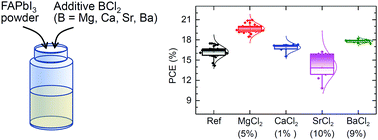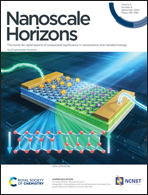Effect of alkaline earth metal chloride additives BCl2 (B = Mg, Ca, Sr and Ba) on the photovoltaic performance of FAPbI3 based perovskite solar cells†
Abstract
Additive engineering is known to be an effective method for inducing a simultaneous effect of enlarging the grain size and surface passivation. As compared to the monovalent halides frequently used as additives, divalent halides are relatively less investigated in the role of additives. In this work, we report effects of alkaline earth metal halides BCl2 (B = Mg, Ca, Sr, Ba) as additives on the opto-electronic properties and photovoltaic performance of FAPbI3 based perovskite solar cells (PSCs). A significant improvement in power conversion efficiency (PCE) from 17.27% to 21.11% is observed by MgCl2 addition in the FAPbI3 precursor solution, while a marginal increment for CaCl2 or BaCl2 and a negative effect for SrCl2 is observed. The lattice constant of cubic FAPbI3 is hardly changed by additives, while the crystallinity is improved by MgCl2. The carrier lifetime increases from 40 ns to 287 ns and the trap density is reduced from 1.08 × 1016 cm−3 to 3.19 × 1015 cm−3 by addition of 5 mol% MgCl2, which is responsible for the enhancement in photovoltaic parameters. The steady-state PCE of the PSC with the MgCl2-additive-treated FAPbI3 measured under continuous illumination at the maximum power point remains unchanged for 1500 s.

- This article is part of the themed collection: Horizons Community Board Collection: Solar Energy Conversion


 Please wait while we load your content...
Please wait while we load your content...